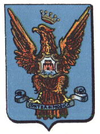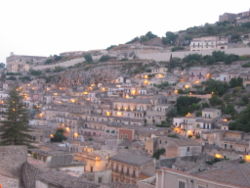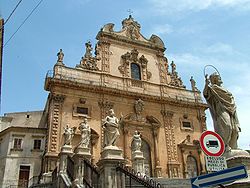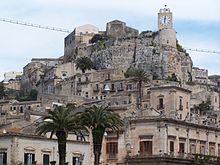- Modica
-
Modica — Comune — Comune di Modica 
Coat of armsLocation of Modica in Italy Coordinates: 36°51′N 14°46′E / 36.85°N 14.767°E Country Italy Region Sicily Province Ragusa (RG) Frazioni Frigintini, Marina di Modica Government - Mayor Antonino Buscema Area - Total 290.77 km2 (112.3 sq mi) Elevation 296 m (971 ft) Population (31 May 2009) - Total 54,581 - Density 187.7/km2 (486.2/sq mi) Demonym Modicani Time zone CET (UTC+1) - Summer (DST) CEST (UTC+2) Postal code 97015 Dialing code 0932 Patron saint St. George Saint day April 23 Website Official website Modica (Sicilian: Muòrica, Greek: Μότουκα, Latin: Mutyca or Motyca) is a city and comune in the Province of Ragusa, Sicily, southern Italy. The city is situated in the Hyblaean Mountains and, along with Val di Noto, is part of UNESCO Heritage Sites in Italy.
Contents
History
According to Thucydides, the city was founded in 1360 BC or 1031 BC and was inhabited by the Sicels in the 7th century BC. It was probably a dependency of Syracuse. Modica was occupied by the Romans after the battle of the Egadi islands against the Carthaginians in the Punic Wars 241 BC, together with Syracuse and all of Sicily. Modica became one of the thirty-five decuman ("spontaneously submitted") cities of the island and was oppressed by the praetor Verres.[1] It became an independent municipium, and apparently a place of some consequence. The city is also mentioned among the inland towns of the island both by Pliny and Ptolemy; and though its name is not found in the Itineraries, it is again mentioned by the Geographer of Ravenna.[2] Silius Italicus also includes it in his list of Sicilian cities, and immediately associates it with Netum (now Noto Antico), with which it was clearly in the same neighborhood.[3]
The southeast of Sicily and Modica (according to the German historian L. Hertling) was rapidly Christianized, as the diocese of Syracuse boasts an apostolic foundation by St. Paul in 61 AD.[4] In 535, the Byzantine general Belisarius expelled the Ostrogoths and established for Justinian I the government of the East-Roman Empire (also improperly known as the Byzantine Empire) and the already Greek-speaking population fixed their culture until the Latinization of the Normans in the 11th century. In 845, Modica was captured by the Arabs who referred to the city as Mudiqah. In 1091 the conquest of Modica and the entire Val di Noto ended the long lasting war of the Normans, led by Roger of Hauteville, against the Arabs.
In 1296, Modica became the capital of an important county, which under the Chiaramonte family became a flourishing semi-independent state controlling the whole southern third of the island, with the right of a mint of its own and other privileges (see County of Modica). The most striking event of the modern era was the earthquake of 1693, which destroyed the entire Val di Noto, although to a slightly lesser extent in Modica.
Annexed to Italy in 1860, Modica remained district capital until 1926, when it was included in the province of Ragusa.
Main sights
As the city developed it gradually became divided into "Modica Alta" (Upper Modica) and "Modica Bassa" (Lower Modica). During the last century the city has extended and developed new suburbs which include Sacro Cuore (or "Sorda"), Monserrato, Idria, these are often referred to as Modern Modica; both old and modern quarters of the city are today joined by one of Europe's higher bridge, the Guerrieri bridge (300 m).
Despite being ravaged by earthquakes in 1613 and 1693 and floods in 1833 and 1902, Modica has maintained some of the most beautiful architecture in Sicily, in the Sicilian Baroque style. The city possesses a large Baroque Cathedral dedicated to San Giorgio. While the cathedral was rebuilt following the earthquake of 1693, like many other parts of the city its roots are in the Middle Ages.
There is another church dedicated to San Pietro in Modica Bassa, featuring a principal façade crowned by a typical Sicilian Baroque belltower 49 m in height.
Other sights include:
- Castello dei Conti (Castle)
- Chiesa del Carmine
- Church of St. Mary of Betlehem
- Garibaldi Theater
- Mercedari Palace -contains a museum and library
Economy
The economy of the area once principally agricultural producing olives, carobs, legumes, cereals, and cattle; an extraordinary and unique product is the famous chocolate of Modica, produced with an ancient and original Aztec recipe. The city has now been joined by factories producing textiles, furniture and cars. Tourism is also an important industry to the area, since Modica entered the UNESCO World Heritage Site in 2002.
Culture
The eighteenth century saw Modica in the role of art and culture town, counting philosophers (Tommaso Campailla), poets (Girolama Grimaldi Lorefice), a school of medicine (Campailla, Gaspare Cannata, Michele Gallo, the Polara family) and literary academies amongst its inhabitants. In the nineteenth century, feudalism was abolished and Modica became a "bourgeois" town peopled by notables such as the writer and anthropologist Serafino Amabile Guastella, the agronomist Clemente Grimaldi, the musician Pietro Floridia and many painters, historians and other intellectuals.
Modica was also the birth place of writer Salvatore Quasimodo, recipient of the Nobel Prize for Literature in 1959.
See also
References
Late Baroque Towns of the Val di Noto (South-Eastern Sicily) * UNESCO World Heritage SiteCountry Italy Type Cultural Criteria i, ii, iv, v Reference 398 Region ** Europe and North America Inscription history Inscription 2002 (20th Session) * Name as inscribed on World Heritage List
** Region as classified by UNESCO This article incorporates text from a publication now in the public domain: Smith, William, ed (1854–57). "article name needed". Dictionary of Greek and Roman Geography. London: John Murray.
This article incorporates text from a publication now in the public domain: Smith, William, ed (1854–57). "article name needed". Dictionary of Greek and Roman Geography. London: John Murray.
External links
- Modica online (Italian)
Categories:- Cities and towns in Sicily
- Municipalities of the Province of Ragusa
- Hilltowns in Italy
- Sicilian Baroque
- Castles in Italy
- Populated places established in the 2nd millennium BC
- World Heritage Sites in Italy
Wikimedia Foundation. 2010.










